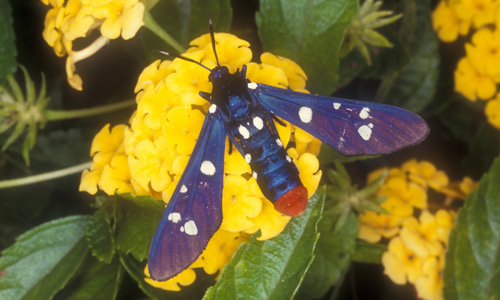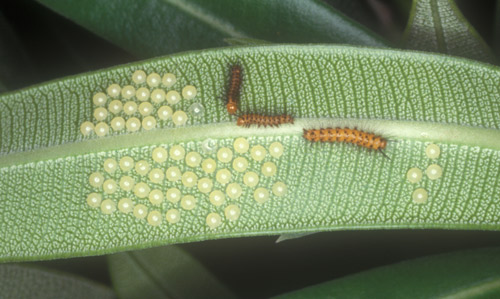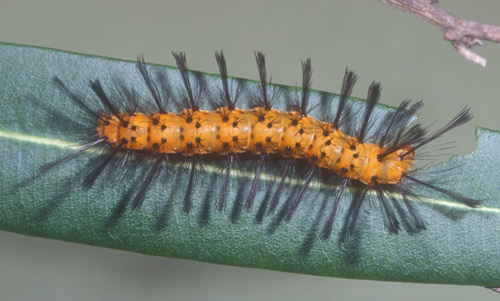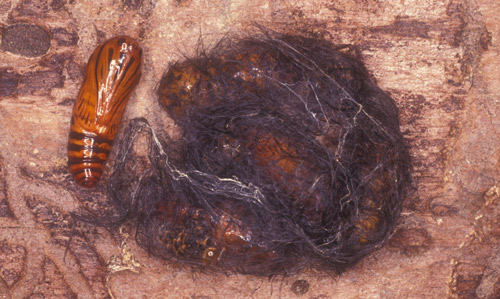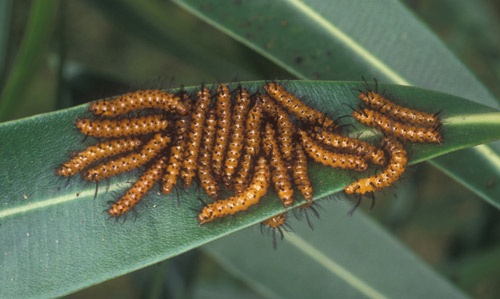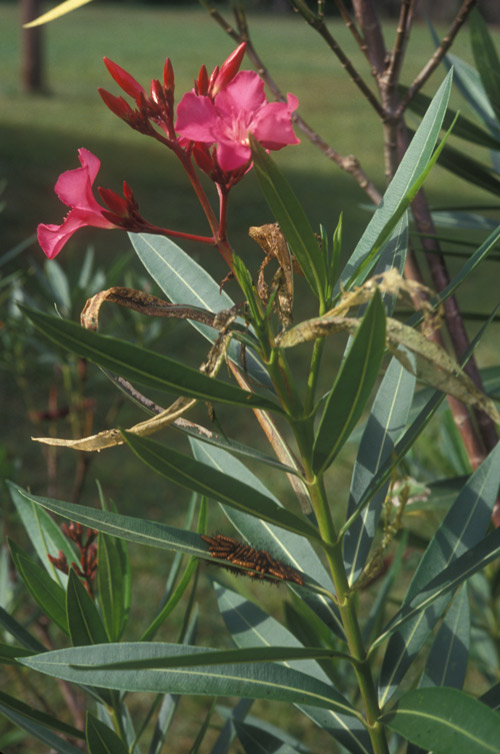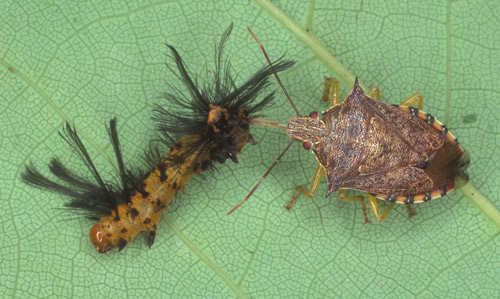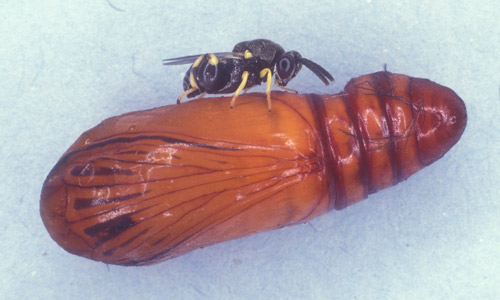common name: oleander caterpillar
scientific name: Syntomeida epilais Walker (Insecta: Lepidoptera: Erebidae: Arctiinae)
Introduction - Distribution - Description - Life Cycle - Damage - Management - Selected References
Introduction (Back to Top)
The oleander caterpillar, Syntomeida epilais Walker, a bright orange caterpillar with tufts of long black hairs, is a common sight on oleanders in Florida and southern Georgia. In southern regions of Florida the oleander caterpillar can cause considerable defoliation. This species is the only caterpillar pest of concern on this ornamental plant, although a related species, the spotted oleander caterpillar, Empyreuma pugione (Linnaeus), may be found occasionally in south Florida and the Keys.
Figure 1. A polka-dot wasp moth, the adult stage of the oleander caterpillar, Syntomeida epilais Walker. Photograph by James Castner, University of Florida.
Distribution (Back to Top)
The oleander caterpillar is a native of the Caribbean region. Its range extends from northern South America, through Central America into Mexico, and from many Caribbean islands into Florida and coastal regions of southeastern states. It is a year round inhabitant of south Florida and the Keys but is usually killed by cold winter temperatures in northern and north-central Florida only to recolonize these areas the following spring. The original host plant is thought to be a now relatively rare beach- or pineland-inhabiting vine, Echites umbellata Jacq. However, the oleander caterpillar is thought to have switched over to feeding on oleander when the Spanish introduced this Mediterranean ornamental plant in the 17th century. The geographic distribution of the oleander caterpillar in America now coincides with that of oleander except that the caterpillar is not found in California.
Description (Back to Top)
Adults: The adult stage of the oleander caterpillar is sometimes called the polka-dot wasp moth. Wasp moth is the common name given to the subfamily of arctiid moths to which this species belongs (the ctenuchines) because of their resemblance to wasps such as the sphecids and pompilids. The moth's body and wings are a beautiful iridescent blue/green. Small white dots are found on the body, wings, legs and antennae, and the tip of the abdomen is red/orange. Male and female moths are quite similar in appearance, and have a wing span of 45 to 51 mm. These moths are slow-flying and active during daylight hours, which contrasts them with other moth species which are usually nocturnal.
Eggs: The eggs are found in clusters on the underside surfaces of oleander leaves. They are pale cream to light yellow in color, spherical in shape, and measure less than 1 mm in diameter.
Figure 2. Egg cluster of the oleander caterpillar, Syntomeida epilais Walker, laid on bottom surface of oleander leaves. Photograph by James Castner, University of Florida.
Larvae: The larvae range in length from 3 to 40 mm and are orange with clumps of black hairs arising from black tubercles (bumps) on the body. Hairs are not urticating (stinging) and handling the larvae will not produce pain unlike certain other hairy caterpillars.
Figure 3. Orange and black larva of the oleander caterpillar, Syntomeida epilais Walker. Photograph by Paul Choate, University of Florida.
Pupae: The pupae are smooth and brown in appearance and are aggregated in depressions on tree trunks or where the walls meet the eaves of buildings. The pupal aggregation is covered by a thin cocoon woven from silk and hairs from their larval skins.
Figure 4. Pupal aggregation of the oleander caterpillar, Syntomeida epilais Walker, covered by a thin cocoon of hairs and silk. Photograph by James Castner, University of Florida.
Life Cycle (Back to Top)
Moths of the oleander caterpillar, unlike most moth species, do not use volatile sex pheromones to locate each other for the purpose of reproduction. In this species, female moths perch on oleander foliage and emit an ultrasonic acoustic signal which, although inaudible to us, attracts male moths from great distances. When male and female moths are within a few meters of each other, they begin a courtship duet of acoustic calls which continues until mating occurs two or three hours before dawn.
Once mated, female moths search for plants on which to lay their eggs. They oviposit on the undersides of the leaves in young growing shoots of oleander plants. Egg masses can contain from 12 to 75 eggs. First instars hatch in two to six days, depending on the temperature, and eat the shells of their eggs. The second and third instars (2 to 4 mm in length) usually feed gregariously on the underside of leaves, progressively moving down the plant. The gregarious feeding stage averages about 8.5 days in the summer.
After molting to the fourth instar, larvae begin to consume the entire leaf rather than just the underneath surface and often are solitary. It is the fourth, fifth and sixth instars that can defoliate entire oleander bushes. This solitary feeding stage averages about 19 days. The mature sixth instars leave the oleander plant and search for a pupation site. The larvae aggregate for some unknown reason and form pupal aggregations covered by a very thin silk cocoon.
Damage (Back to Top)
Early infestation by the oleander caterpillar is easy to recognize. The young, gregariously feeding larvae turn the new oleander shoots a light brown color due to their skeletonizing feeding behavior (leaving the major and minor leaf veins untouched while eating the tissue in between). Examination of the underneath surface of these brown leaves or those leaves slightly below the damaged foliage will reveal a group of small larvae. At this stage the insect is very easy to control. If caterpillars are allowed to grow beyond the small, gregarious stage, they can inflict a lot of unsightly defoliation on the oleander unless nature or human intervention stops them. Total defoliation will not kill the plant but, if it occurs repeatedly year after year, the plant may be more susceptible to other pests such as scale insects.
Figure 5. Control of the oleander caterpillar, Syntomeida epilais Walker, is easiest during its gregarious feeding stage. Photograph by James Castner, University of Florida.
Figure 6. Skeletonized oleander terminals are the first sign of infestation by the oleander caterpillar, Syntomeida epilais Walker. Photograph by James Castner, University of Florida.
Management (Back to Top)
Biological control. Birds are often great predators of caterpillar pests in the landscape. However, because of the poisonous diet of the oleander caterpillar, birds and small mammals do not feed on this abundant resource. Several other insect species however are able to feed on the oleander caterpillar. Natural enemies include predatory stink bugs, parasitic tachinid flies and wasps, and the ever voracious red imported fire ant. Stink bugs have been observed sucking the juices out of larvae. Tachinid flies lay their eggs on large larvae and wasps lay their eggs on pupae. The progeny of these parasitic insects then devour the oleander caterpillar. Fire ants often discover the pupal aggregations and eat this immobile life stage. Viral, fungal and bacterial diseases can be quite prevalent in certain years and can cause tremendous levels of mortality. Pathogen-infected larvae are often dark in color, flaccid and easily "liquified". While these pathogen-infected larvae may look "gross", leaving them on the oleander bushes will allow the disease to spread within the oleander caterpillar population.
Figure 7. The spined soldier bug, Podisus maculiventris (Say), sucking the contents of an oleander caterpillar larva, Syntomeida epilais Walker. Photograph by James Castner, University of Florida.
Figure 8. Parasitic wasp, Brachymeria incerta, laying egg in a pupa of the oleander caterpillar, Syntomeida epilais Walker. Photograph by James Castner, University of Florida.
Cultural control. Removal of larvae-infested foliage is the most environmentally friendly method of controlling the oleander caterpillar and is relatively easy on bushes of less than 2 m in height. Simply use a pair of scissors or pruners to snip off the damaged foliage and the group of feeding larvae. Put the infested plant material in a plastic bag and freeze for 24 hours to kill the caterpillars. Because of the poisonous nature of the plant sap, care must be taken to wash the hands immediately after disposing of the pruned plant material. Large larvae can be hand picked and frozen similarly or dropped into a container of soapy water. This method has none of the possible side effects, such as killing beneficial biological control agents or risking human insecticide exposure, that can occur with insecticidal control. It is difficult to remove larvae from very tall bushes, however. There are no oleander cultivars that are resistant to oleander caterpillar but it has been suggested that dwarf cultivars may be less susceptible.
Chemical control. Application of insecticides should be considered as a last resort for this insect which, while producing unsightly damage, does not kill oleander. Bacillus thuringiensis, a microbial insecticide that is sold under various trade names, is a bacterium that kills only lepidopteran larvae. It has no toxicity toward beneficial insects.
Selected References (Back to Top)
- Bratley HE. 1932. The oleander caterpillar, Syntomeida epilais Walker. Florida Entomologist 15: 55-64.
- McAuslane HJ, Bennett FD. 1995. Parasitoids and predators associated with Syntomeida epilais (Lepidoptera: Arctiidae) on oleander. Florida Entomologist 78: 543-546.
- Reinert JA. 1974. Bacillus thuringiensis for control of the oleander caterpillar. Proceedings of the Southern Nursery Association Research Conference 19: 44-45.
- Reinert JA. 1980. Control of the oleander caterpillar on oleander. Proceedings of the Florida State Horticultural Society 93: 168-169.
- Rothschild M, von Euw J, Reichstein T. 1973. Cardiac glycosides (heart poisons) in the polka-dot moth Syntomeida epilais Walk. (Ctenuchidae: Lep.) with some observations on the toxic qualities of Amata (=Syntomis) phegea (L.). Proceedings of the Royal Society of London B 183: 227-247.
- Sanderford MV, Conner WE. 1990. Courtship sounds of the polka-dot wasp moth, Syntomeida epilais. Naturwissenschaften 77: 345-347.
